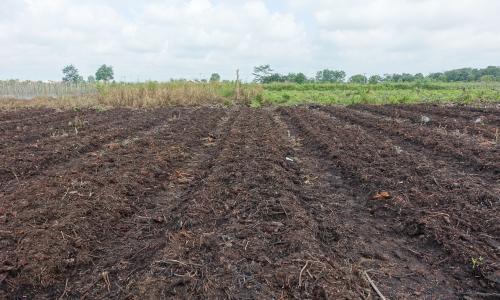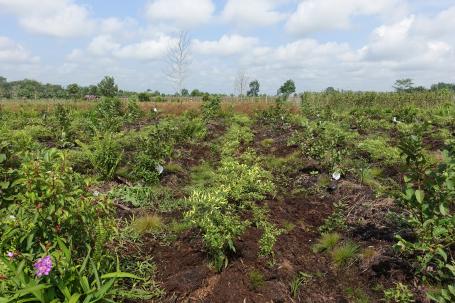
Drying Peat, Losing Farmers!
This article was previously published by People For Peat on June 28, 2022.
That afternoon, upon landing at Supadio Airport, Pontianak, Central Kalimantan, the four of us from WRI Indonesia went straight to Mulyorejo Hamlet, Limbung Village, Kubu Raya District along with Ronny Christanto, an independent environmental researcher from Pontianak. The air was stifling and hot when we got to the peatlands not far from Supadio Airport. We visited Limbung Village to supervise the research activities on peatlands by Ronny and his team, who received funding from The Sustainable Use of Peatland and Haze Mitigation in ASEAN (SUPA), which was funded by the European Union.
Shortly after leaving Supadio Airport, we left the main road and entered a narrow concrete road that only fit one car. The people's houses lined up on our right and left in low density. About 20 minutes since we departed from Supadio Airport, we arrived at a location near Ronny's research demonstration plot. We parked the car and continued our journey on foot for about 300 meters. As we were walking, Ronny told us about the location. “The people here usually use the land for farming. They commonly grow chili, ginger, tomato, but production is not significant. They would sometimes lose money because whatever they make doesn’t cover the cost.”
During that walk, we met two farmers working on their farms. Pujianto and Kusmawadi, the two farmers, were residents of Mulyorejo Hamlet. They both work as farmers and have tried growing different plants on peatlands with some success. The chili and tomato farms managed by Pujianto and Kusmawadi used to produce relatively high yields. Their tomato farm of 25 x 20 square meters at one point produced 700 kilograms of tomatoes. They then sold the tomatoes at Rp7,000 per kilogram. They were also successful in farming chilies. From an area of 80 x 20 square meters, they produced 1 ton of chili when the selling price hit Rp70,000 per kilogram. This was at the end of 2021.
Unfortunately, everything changed drastically in just over six months. "The current crop is not good," said Pujianto describing his predicament with the current batch of chili. He explained that his plot of land could not meet the water requirement for growing chilies. "Right after we planted them, we didn’t have water for two weeks," he said. Pujianto explained that chili farming is impossible without enough water. We saw ourselves how dry the area was. Meanwhile, according to Pujianto, chili or tomato plants need water for 36-42 days out of a total of 2 months of cultivation, from planting to harvesting.
Water shortage for plants is definitely a problem for farmers. Pujianto and Kusmawadi experienced this firsthand as they had to spend around Rp1.5 million for the tomatoes and around Rp2 million for the chilies. With such a low yield, they suffered losses. Instead of profiting off of it, they lost the money they spend on cultivation and got nothing in return.

Water availability is essential for plants. However, ensuring water sufficiency for crops on peatlands poses many challenges as water availability is heavily affected by seasons. During the long dry season, farmers will find it difficult to maintain water sufficiency. Meanwhile, peatlands such as those cultivated by Pujianto and Kusmawadi have no water sources and thus depend on rainwater. Moreover, the peatland they cultivate have been burned multiple times, reducing the water absorption capability of the peat soil. Pujianto and Kusmawadi along with other farmers continue to try to anticipate such water availability problems in their plots of land through efforts such as making small ponds near their lands as a source of water for the plants in the dry season. They then use the ponds to water the plants manually or use a water pump. Irrigation using a water pump, however, is costly. As such, Pujianto and Kusmawadi have to rely on their luck in farming on peatlands. In the end, facing an unpredictable season, they have two choices: not planting crops to avoid the risk of financial loss in the event of a water shortage or continue farming and accept whatever outcome they get.